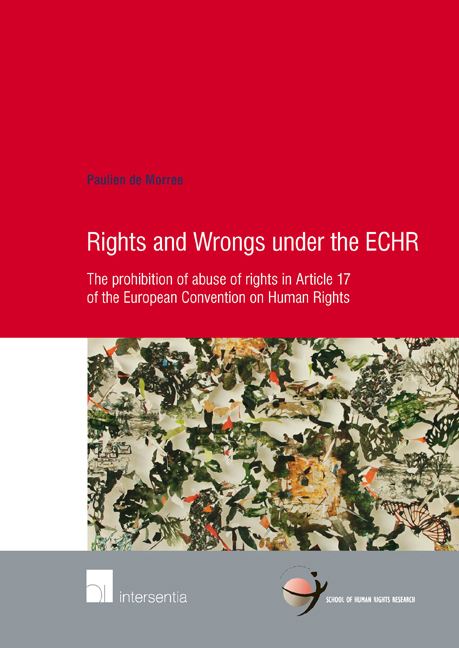 Rights and Wrongs under the ECHR
Rights and Wrongs under the ECHR Published online by Cambridge University Press: 12 December 2017
INTRODUCTION
In the previous chapter we have learned that the prohibition of abuse of rights in human rights law takes a distinct form, namely as an attempt to destroy the democratic system, and its values and principles. The purpose of the abuse clause is a very fundamental one, as its central concern ‘is not the impact on others but on the democratic regime as such’. These abuse clauses in the different international and regional human rights instruments (with the exception of the ACHR), like Article 17 ECHR aim to prevent groups and individuals from relying on human rights for the purpose of engaging in activities aimed at the destruction of these rights. Abuse in this context is not based on the rights of others, which is the main focus of the abuse of rights in general, ‘but on the democratic regime as such, which is endangered by the improper use of fundamental human rights’, as Sajó puts it. In other words, the abuse clause in human rights law reflects concern for the defence of democracy and fundamental rights, and precludes actions which undermine these principles. The legal strife against anti-democratic actors aiming to destroy democracy is the principal focus of the concept of militant democracy. To better understand Article 17 ECHR, it is therefore important to learn more about the interpretation and implications of the concept of militant democracy.
This chapter is the first of three chapters that focus on the concept of militant democracy. It examines the concept of militant democracy from a theoretical perspective. The following two chapters will subsequently explore the implementation of this concept in a concrete legal context. Chapter eight discusses the interpretation of the concept in the German constitutional order and Chapter nine explores how the concept takes shape in the context of the ECHR (in particular with regard to the interpretation of Article 17 ECHR). In what follows, we will start by examining the historical background of the concept of militant democracy. This chapter then moves on to the theoretical foundations of the concept. Subsequently, it explores how the concept of militant democracy has been put into practice in European democracies after the Second World War and how the implementation of the concept has been perceived in legal doctrine. Finally it reflects on the criticism that has been voiced with regard to the application of the concept of militant democracy.
To save this book to your Kindle, first ensure [email protected] is added to your Approved Personal Document E-mail List under your Personal Document Settings on the Manage Your Content and Devices page of your Amazon account. Then enter the ‘name’ part of your Kindle email address below. Find out more about saving to your Kindle.
Note you can select to save to either the @free.kindle.com or @kindle.com variations. ‘@free.kindle.com’ emails are free but can only be saved to your device when it is connected to wi-fi. ‘@kindle.com’ emails can be delivered even when you are not connected to wi-fi, but note that service fees apply.
Find out more about the Kindle Personal Document Service.
To save content items to your account, please confirm that you agree to abide by our usage policies. If this is the first time you use this feature, you will be asked to authorise Cambridge Core to connect with your account. Find out more about saving content to Dropbox.
To save content items to your account, please confirm that you agree to abide by our usage policies. If this is the first time you use this feature, you will be asked to authorise Cambridge Core to connect with your account. Find out more about saving content to Google Drive.